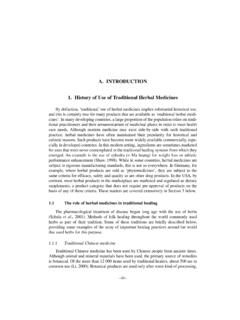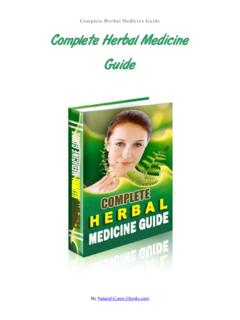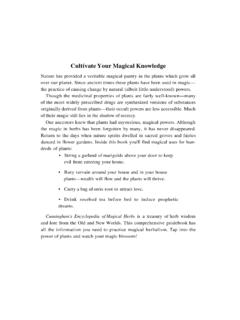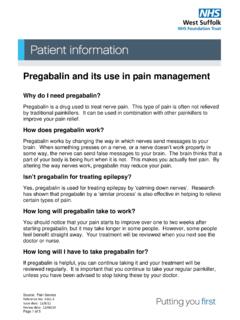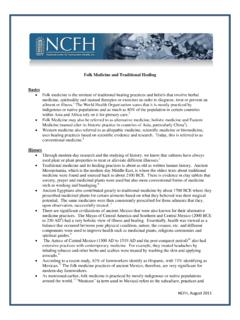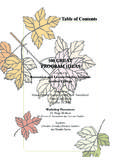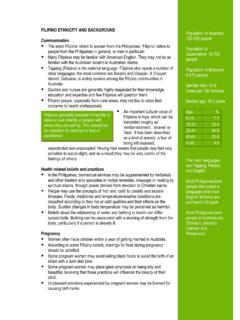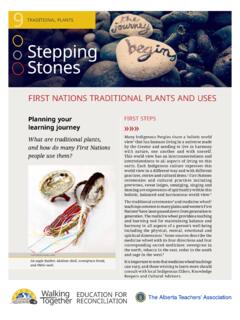Transcription of The Blue Guide - GOV.UK
1 The blue Guide Advertising and Promotion of Medicines in the UK Third Edition Third revision - November 2020 Medicines and Healthcare products Regulatory Agency THE blue Guide ADVERTISING AND PROMOTION OF MEDICINES IN THE UK Medicines and Healthcare products Regulatory Agency Third Edition Third revision - November 2020 2 MHRA Contact Points for Advice on Advertising and Promotion of Medicines Advertising Standards and Outreach Unit Medicines and Healthcare products Regulatory Agency 10 South Colonnade LONDON E14 4PU General advice and information on advertising and promotion of medicines, including a copy of this guidance, is available on the MHRA website at For general enquiries about advertising of licensed medicines and legislation For enquiries about advertising policy Email: Tel: 020 3080 6523/6452 Email: Tel: 020 3080 6765/7771/6039 For general enquiries about the MHRA: Customer Services E-mail: Tel: 020 3080 6000 3 Record of changes - Third edition The Third Edition of the blue Guide was published in August 2012.
2 It has been made available as an online resource rather than a printed publication with the expectation that it would be a dynamic document updated at regular intervals as required. The following three specific updates have been made since 2012: September 2014: 1. Changes to reflect the Human Medicines (Amendment No. 2) Regulations 2014 to simplify the information requirements for advertising to healthcare professionals and other suppliers of medicines (primarily sections and and annexes 1, 4 and 5). 2. Additional advice on prohibited gifts and benefits (section ) 3. Updated guidance for providers offering medicinal treatment services (section and appendix 6). 4. Updated information about adverse drug reaction reporting (section ).
3 5. Additional clarification concerning advertising of medicines for use in pregnancy (Appendix 3). 6. Updates to contact details for MHRA staff and information about NICE, ABPI and PMCPA. July 2019: 1. Addition of information about General Pharmaceutical Council guidance and the Distance Selling Logo to the guidance for providers offering medicinal treatment services (appendix 6). 2. Removal or updating of references to the Office of Fair Trading (sections and ) and updated information about Radiocentre (section ). 3. Update to MHRA contact details. November 2020: 1. Changes to permit limited advertising in certain types of public health emergency, reflecting the Human Medicines (Coronavirus and Influenza) (Amendment) Regulations 2020 (section ).
4 2. Changes to include new licence categories for Great Britain and Northern Ireland and reflect the Human Medicines (Amendment etc.) (EU Exit) Regulations 2019 as amended by the Human Medicines (Amendment etc.) (EU Exit) Regulations 2020 (primarily sections , , and Annex 3) and removal of references to European law. 3. Additional advice on samples (section ) and clinically proven claims and free offers (Appendix 6) and updated information on the Medicines and Devices Advertising Liaison Group (section ). 4 CONTENTS Chapter 1 GENERAL INTRODUCTION 09 Introduction 09 Medicines regulation 09 Regulation of advertising 09 Development of the blue Guide 11 Further information 11 Chapter 2 HOW TO COMPLAIN 12 Introduction 12 When to complain 12 What will happen next?
5 12 LEGAL REQUIREMENTS FOR MEDICINES ADVERTISING 14 IN THE UK Chapter 3 THE LEGISLATIVE FRAMEWORK 15 Introduction 15 The legal basis for the control of medicines advertising 15 Scope of the Regulations 15 Other legislation relevant to medicines advertising 17 Where to get the legislation 18 5 Chapter 4 GENERAL RULES 19 Introduction 19 Prohibition on advertising unlicensed medicines 19 Quality standards 20 Who is responsible? 22 Updating advertising 22 Keeping records 22 Special requirements for traditional herbal medicinal products 23 (THMs) Special requirements for registered homeopathic medicines 24 Chapter 5 ADVERTISING TO THE PUBLIC 25 Introduction 25 Medicines suitable for advertising to the public 25 Prohibition of certain material 25 Children 26 Information necessary for the correct use of a medicine 26 Advice on claims 27 Recommendations and endorsements 28 Sponsorship 28 Samples for promotional purposes 28 Advertising on the Internet 29 Multiple purchase promotions for analgesics 29 6 Chapter 6 ADVERTISING TO PERSONS QUALIFIED TO PRESCRIBE 30 OR SUPPLY MEDICINES Introduction 30 Scope of "persons qualified to prescribe or supply" 30
6 Advertising on the Internet 31 Provision of information - full advertisements 31 Provision of information short form advertisements 33 Safety messages given in advertising 34 Urgent safety restrictions or safety variations 35 Trade advertisements 35 Promotional aids 36 Advertising intended for international publication 36 International meetings 36 Professional samples 37 Medical sales representatives 38 Gifts, inducements and other benefits 38 Interpretation of "inexpensive" and "relevant to the practice 39 of medicine or pharmacy" Hospitality 40 Provision of medical or pharmaceutical education, goods 40 and services Co-promotion 40 Chapter 7 PROVIDING NON-PROMOTIONAL INFORMATION ABOUT 41 PRESCRIPTION ONLY MEDICINES TO THE PUBLIC Introduction 41 Independent information sources 41 Promotion of services 41 Disease awareness and health education campaigns 42 Internet sites 42 Materials for patients 42 Press releases and other information to the media 43 Responses to enquiries from the public 44 REGULATION OF MEDICINES ADVERTISING IN THE UK 45 Chapter 8 THE ROLE OF THE MHRA 46 Introduction 46 Vetting of advertising material 46 Scrutiny of current advertising material 47 Complaints about medicines advertising 48
7 Corrective statements 50 Seeking advice on advertising 51 Chapter 9 STATUTORY ACTION 52 Introduction 52 Taking statutory action 52 Independent Review Panel (IRP) 53 Determinations 53 Sanctions 54 Chapter 10 SELF-REGULATION 55 Introduction 55 The regulatory regime 55 Vetting of advertising material 57 Investigation of complaints 58 Medicines Advertising Liaison Group (MALG) 59 ANNEXES 60 1. Relevant legislation 61 2. Other UK legislation that affects medicines advertising 64 3. Particulars to be included in advertisements to the public 68 4. Particulars to be included in advertisements to persons 69 qualified to prescribe or supply 5.
8 Particulars to be contained in short form advertisements 70 6. Other regulatory and self-regulatory bodies 71 APPENDICES Guides 72 1. Registered traditional herbal medicines: Guidance for consumer 74 advertising 2. Homeopathic medicines: Guidance on advertising 82 3. Medicines which are promoted for use during pregnancy: 89 Guidance for the pharmaceutical industry 4. Best practice on the sale of medicines for pain relief 93 5. Reporting to the public on medicines: Advice for journalists 95 and patient organisations 6. Advertising of medicines: Guidance for providers 98 offering medicinal treatment services 7. Disease Awareness Campaign Guidelines 104 8. Guidance on review of advertising by an Independent Review 107 Panel GLOSSARY 112 9 Chapter 1 GENERAL INTRODUCTION Introduction This chapter introduces the controls on medicines advertising in the UK and provides background information on the development of the blue Guide .
9 It also provides a general introduction to the regulation of medicines in the UK. Medicines regulation Medicines have the potential for benefit to individuals who use them and to the public health. But all effective medicines may be associated with adverse effects. The law recognises that medicines should not be treated as an ordinary general commodity by placing specific restrictions on them. There is a specific licensing system for medicines, operated in the UK by the Medicines and Healthcare products Regulatory Agency (MHRA). The MHRA is the Government agency which is responsible for ensuring that medicines and medical devices work, and are acceptably safe. Its work is underpinned by robust and fact-based judgements to ensure that the benefits to patients and the public justify the risks.
10 Its licensing schemes cover the whole range of medicines for human use, from registration for herbal and homeopathic remedies to marketing authorisation for the latest innovative advanced technology medicinal products. This Guide uses the general term licence to refer to all these schemes. The basis of the licence for any medicine is the Summary of Product Characteristics (SPC). This sets out the details of what the product is licensed for, how it should be administered and warnings and side effects. The SPC sets the boundaries for what can be claimed in advertising for the product. The lic/ence also determines how the product may be supplied. This may be on prescription only or non-prescription, either through pharmacies under the supervision of a pharmacist or on general sale.










